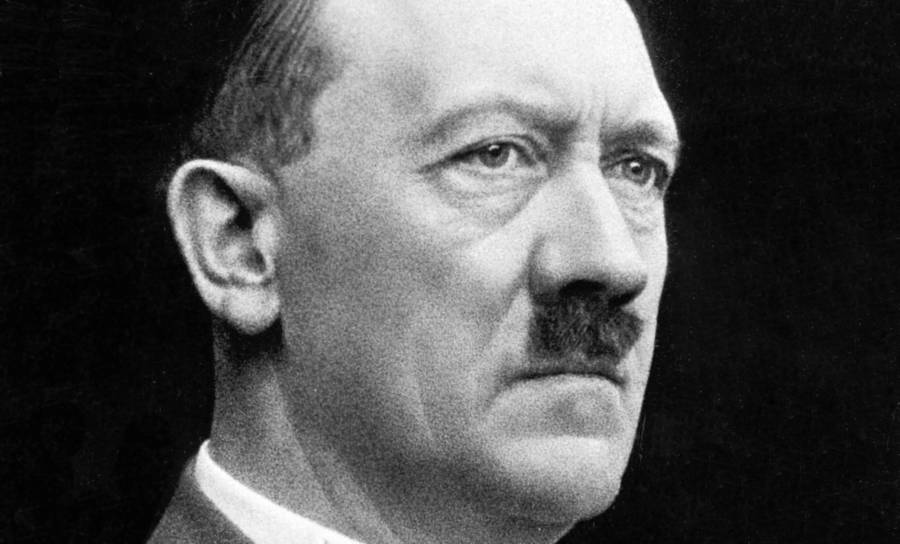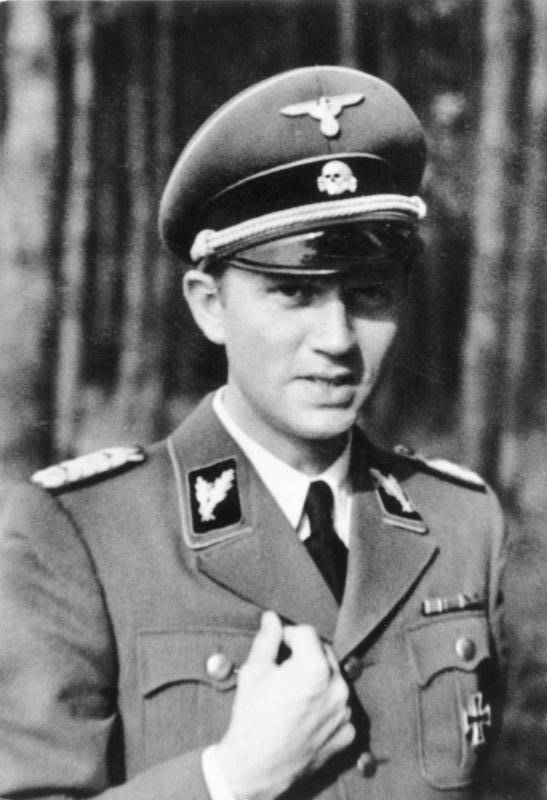What really happened to the Führer? These Hitler death conspiracy theories, from the plausible to the outlandish, claim to have the answers.

Wikimedia Commons
On May 1, 1945, with world war ii about to end, the Red Army was fighting its way into the central district of Berlin. Meanwhile, American and British forces were beginning the mammoth task of processing the thousands of German prisoners taken in the fighting in Nuremberg, where an entire SS division had made its last stand, and of cataloging the vast treasures they had captured there.
On that day, the Grand Admiral of the German Navy, Karl Dönitz, delivered a radio broadcast to the broken Reich. In it, he announced that Adolf Hitler was dead and that he had died gallantly leading men in battle against Soviet forces. Dönitz claimed that Hitler had named him as his successor in his last testament and that everything was, basically, fine.
Business would continue as normal, with the German government “temporarily” headquartered in Flensburg. Ten days later, Dönitz was in Allied custody, as were many other leading Nazis. In his effects was found a single telegram from Nazi propaganda minister Joseph Goebbels in Berlin, also now dead, announcing Hitler’s death and omitting the bit about the Führer having fallen in combat, which seems to have been Dönitz’s own invention, since he had no other evidence of what had actually happened to Hitler in Berlin.
Within days, the war was over and the Third Reich was no more, but the fact that Hitler’s body hadn’t turned up rankled the Western Allies. Hitler wasn’t supposed to mysteriously vanish into history — he was supposed to either stand trial or drop dead and leave a corpse to be verified.
Thus was born a myth of Hitler’s survival — and a host of Hitler death conspiracy theories — one that still persists and was even reignited by the 2015 release of secret FBI documents containing reports that Hitler had escaped Germany in a U-boat and fled to Argentina.
The myth, it seems, lives on.
“The Obstinate Love Of Fiction”

Konstantin ZAVRAZHIN/Gamma-Rapho via Getty ImagesThe skull once claimed to be that of Adolf Hitler on display in Moscow on April 26, 2000.
Part of the problem with investigating the Führer’s demise — and easily debunking some of the Hitler death conspiracy theories — is that the only people who were in a position to know what happened with any certainty were the Soviets, and they weren’t eager to share information or be honest with the Allies who became their Cold War enemies.
Between the end of the war in the spring of 1945 and the fall of the USSR in 1991, Soviet authorities put out so many contradictory and self-refuting statements about Hitler’s death that some of it must have been conscious disinformation.
After initially claiming that Hitler was dead and that they had the remains to prove it, the Soviets then put out word that they didn’t have the body and then accused the British of smuggling Hitler and Braun out of Germany.
After that, they claimed to have a fragment of Hitler’s skull with a conveniently positioned bullet hole in it. Then, decades later, forensic examination revealed that the fragment was that of a woman.
Despite such misinformation, Allied investigators tried to get to the bottom of things by interviewing anybody in Germany who might have known what happened inside Hitler’s bunker in the last days of the war.

Wikimedia CommonsWalter Schellenberg
One of the people deposed by the British was an SS general named Walter Schellenberg, who was apprehended after the war in Sweden. According to him, Himmler had poisoned Hitler on his advice. The advantages to telling this story of betraying Hitler were obvious for a former Gestapo general looking to avoid punishment, and since he hadn’t actually been present for many of the meetings he claimed to have led, the Allies dismissed his story.
Another informant was a woman who claimed she had been at the center of a German intelligence ring from inside the concentration camp at Ravensbrück. This woman, whose name was Carmen Mory, swore she had firsthand knowledge that Hitler, Eva Braun, and others were living in Bavaria under assumed names. She also threatened to kill herself if the British didn’t make concessions to her regarding her treatment and let her go.
Mory, as it happens, was facing trial for war crimes at the time for having actually been a Gestapo spy inside Ravensbrück, where her information got 60 other women killed. She committed suicide in 1947 after the British sentenced her to hang.
Yet another unreliable witness was Luftwaffe pilot Peter Baumgart, who claimed he had personally flown Hitler to Denmark on April 30, 1945. He eventually checked himself into an insane asylum and stopped claiming to have aided Hitler’s escape.
The British report on these informants, written by historian Hugh Trevor-Roper, concluded that none of the “firsthand accounts” were credible, and neither was that of Dönitz, writing that: “[R]eason is powerless against the obstinate love of fiction.”
Escaping Nazis

Corbis/Getty ImagesPresident John F. Kennedy and Vice President Lyndon B. Johnson Converse With Wernher von Braun at Cape Canaveral.
While the British were leaving esteemed historians (and deep-cover MI-6 spooks, like Trevor-Roper) to despair of ever knowing the truth, the Americans were, ironically, lending credence to Hitler death conspiracy theories stating that he and other prominent Nazis had escaped. The Americans did so by actually helping prominent Nazis escape themselves.
Operation Paperclip was a project of the Office of Strategic Services (the U.S. intelligence agency at the time) to identify and extract German scientists and counterintelligence officers in order to keep them out of Soviet hands. These Germans, like Wernher von Braun, went on to lead the American space program and use their experience as Nazi torturers to uncover and frustrate communist subversion of the new West German state. The Soviets were surely aware of all this, which may have motivated some of their refusal to clear up the details surrounding Hitler’s death for their Cold War enemies.
The subject of Nazis escaping justice came up from time to time in the decades after the war. Some Nazi diehards, such as SS officer Otto Skorzeny, were known to have set up a “rat line” to smuggle their former comrades out of occupied Europe and (usually) into South America, where friendly governments would shelter them from prosecution.
With such prominent individuals as SS leader Adolf Eichmann and infamous concentration camp doctor Josef Mengele making it out of Germany this way, it didn’t seem impossible that their leader had also made it out, thus fueling plenty of Hitler death conspiracy theories.
Sightings Of Adolf Hitler After World War 2

Wikimedia CommonsThe above-ground portion of the bunker where Hitler spent his final days before it was destroyed in 1947.
During his life, Adolf Hitler made public appearances and speeches to tens of millions of people. Between 1933 and 1945, his face was printed on hundreds of millions of postage stamps, picture postcards, newspapers, and magazines, as well as other mass-circulation items. His face, in other words, was well-known.
If the Hitler death conspiracy theories were true and he had escaped, it wouldn’t be easy for him to hide and it would be easy for passerby to recognize him. So when informants started cropping up all over the world, such as one Argentine expat in Los Angeles in September 1945, who claimed he had personally seen Hitler and his entourage getting settled into their new homes at the foot of the Andes, the FBI stepped in to investigate.
The FBI’s investigation pulled from multiple sources all over the world and it was eventually joined by a parallel investigation by the CIA. The CIA effort, which ran into the early 1960s, included a sighting report from an SS veteran named Phillip Citroen, who claimed to have been in regular contact with Hitler in Colombia, and that the former Führer moved to Argentina in January 1955 during a spell of bad health.
The CIA report on Citroen’s statements even included a microfilmed photograph that purported to show Citroen sitting with Hitler in South America. In the end, after chasing down hundreds of leads on at least three continents, both the FBI and CIA concluded they couldn’t prove anything without some hard evidence and closed their cases.
Hitler Death Conspiracy Theories In Popular Culture

Wikimedia Commons
The official FBI and CIA search for the fugitive Adolf Hitler may have ended with a whimper, but unofficially, the idea that the most wanted man in history may have faked his death and escaped was too good not to enter the culture in various ways, with Hitler death conspiracy theories popping up again and again.
A 2011 book by British authors Simon Dunstan and Gerrard Williams, titled Grey Wolf: The Escape of Adolf Hitler, purported to be a factual examination and biography of the postwar Hitler family: Adolf, Eva, and their daughter Ursula. The book was blasted like a furnace by mainstream historians, who called it trash upon its release.
But as the ancient proverb goes: “if it’s trash and it involves Hitler, it’ll be on The History Channel during May sweeps.”
So it was that, in 2015, The History Channel began running a pseudo-documentary series called Hunting Hitler, which put forward the Hitler death conspiracy theory that he had escaped war-ravaged Europe with his wife aboard a U-boat to Argentina. The program’s writers, evidently not having easy access to a world map, claimed that the U-boat stopped briefly in Madagascar on its way to Buenos Aires.
A Fitting Tribute

ullstein bild via Getty ImagesTaken on April 29, 1945, just one day before his suicide, this is widely believed to be the last photo of Adolf Hitler (right), seen here surveying the ruins of the Reich chancellery in Berlin with his adjutant, Julius Schaub.
In a bizarre way, all the circus-like speculation and Hitler death conspiracy theories would probably have pleased the man himself no end. Based on statements made by people who had actually been present in the bunker at the end, many of them spoken in confidence to WWII researcher and bestselling author David Irving, it is clear that Hitler was serious about disappearing from the world without a trace.
Hitler’s adjutant, SS officer Otto Günsche, reported being ordered to find several liters of gasoline, suitable for burning remains, a day or two before Hitler’s suicide.
Furthermore, Hitler seems to have settled on April 30 as his suicide date because it was the latest day when he could be sure there would still be time to burn him properly and disperse the ashes before the Red Army took the Chancellery. His concern seems to have been that no trace of his remains should ever be recovered to serve his enemies as a trophy.
Funny enough, such drama was predicted years before it happened by a then-obscure document commissioned by the Office of Strategic Services. In 1943, the OSS asked prominent psychologists to assess what was then known about Hitler from his public and private utterances as well as anecdotal statements from people who had known the man personally.
The resulting report goes on for a bit about how Hitler saw himself in relation to his place in history, and then it offers a list of likely outcomes for when the fighting inevitably turned against Germany and Hitler’s fall became a certainty.
Among the eight possible endings the team saw for Hitler, the outcome they rated as most likely read as follows:
“It is probably true that he has an inordinate fear of death, but being an hysteric he could undoubtedly screw himself up into the super-man character and perform the deed. In all probability, however, it would not be a simple suicide. He has too much of the dramatic for that and since immortality is one of his dominant motives, we can imagine that he would stage the most dramatic and effective death scene he could possibly think of. He knows how to bind the people to him and if he cannot have the bond in life he will certainly do his utmost to achieve it in death.”
In other words, given that the mystery of his death and disappearance is still inspiring talk over 70 years later, Adolf Hitler wouldn’t have had it any other way.
After this look at conspiracy theories about Adolf Hitler’s death, read up on Hitler’s descendants who are determined to end the bloodline as well as Jean-Marie Loret, the man who claims to be Hitler’s son. Then, see some haunting Holocaust photos that document one of history’s greatest tragedies.





